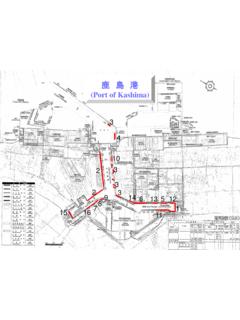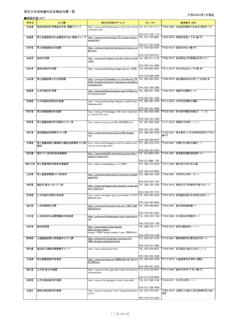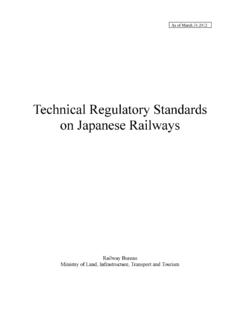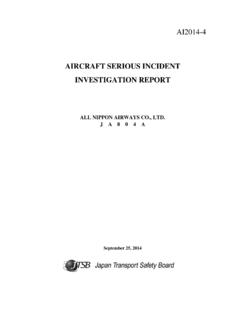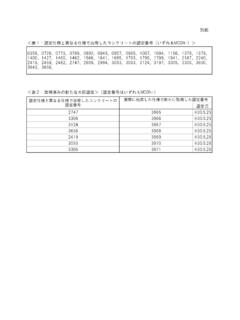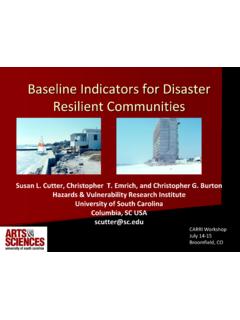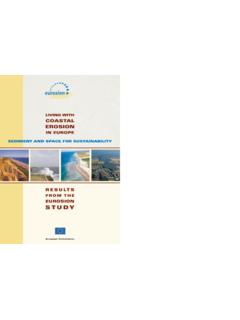Transcription of Priority Plan for Infrastructure Development - mlit.go.jp
1 Priority plan for Infrastructure Development The Cabinet Decision on September 18, 2015. Ministry of Land, Infrastructure , Transport and Tourism Priority plan for Infrastructure Development 1. What is the Priority plan for Infrastructure Development ? The Priority plan is formulated to promote the Infrastructure Development projects in an intensive, effective and efficient manner in accordance with the Act on Priority plan for Infrastructure Development (Act of 2003). The Cabinet decision is needed for formulation of the Priority plan . The Act targets at projects related to roads, traffic safety facilities, railways, airports, ports/harbors, aids to navigation, park/green space, sewage system, rivers, erosion and land slide prevention, steep slope and coast revetment, including the projects or affairs to be undertaken in connection with those projects in order to enhance the effectiveness. 1st Priority plan (from FY2003 to FY2007), 2nd Priority plan (from FY2008 to FY2012), 3rd Priority plan (from FY2012 to FY2016), and 4th Priority plan (from FY2015 to FY2020) had been already formulated.
2 Major planning matters - Priority objectives regarding the implementation of the Infrastructure Development projects during the period for the plan - Overview of the Infrastructure Development projects that should be implemented in an intensive, effective and efficient manner during the period for the plan in order to accomplish the Priority objectives. - Measures for implementing the Infrastructure Development projects in an intensive, effective and efficient manner, etc. 2. Background of the formulation of the 4th Priority plan June 3, 2015 Consultation with the Council of Infrastructure Development and the Council of Transport Policy regarding revision of the Priority plan for Infrastructure Development July 3, 2015 Presentation of the 4th Priority plan (draft). July 24, 2015 Presentation of the 4th Priority plan (second draft). July 30, 2015 Public comment and hearing of opinions from the prefectural governments, etc.
3 September 1, 2015 Presentation of the 4th Priority plan (final draft). September 14, 2015 Report by the Council of Infrastructure Development and the Council of Transport Policy September 18, 2015 Cabinet decision Priority plan for Infrastructure Development History of the Priority plan for Infrastructure Development Nine plans are formulated by project area: Setting the project amount by each plan Roads Traffic safety Airports Ports/ Urban parks Sewage Flood Steep slope Coasts facilities Harbors management Criticism against the nine plans Criticism against Infrastructure Development The plans result in loss of flexibility in budget allocation Prioritization of projects and efficiency of operation are not Vertically-segmented planning makes mutual collaboration difficult. promoted. The plans are no more than a means for acquiring budget. Opinions from the local governments and citizens are not fully ,etc. reflected.
4 ,etc. Unification Priority plan for Infrastructure Development (Act on Priority plan for Infrastructure Development Act of 2003). 1st Priority plan (from FY2003 to FY2007), 2nd Priority plan (from FY2008 to FY2012), 3rd Priority plan (from FY2012 to FY2016), 4th Priority plan (from FY2015 to FY2020). BEFORE CURRENT Priority plan . Example of the project expenses in the former long-term plan Major planning matters of the Priority plan for Infrastructure Development Five-Year Road Development plan (from FY1998 to FY2002). A total trillion yen, which includes: trillion yen for the Development of new arterial high-standard highways that extend to a length of 1,360 km Priority objectives regarding the implementation of the Infrastructure Flood management project Seven-Year plan (from FY1997 to FY2003) Development projects during the period for the plan (instead of recording A total trillion yen, which includes: the total amount of future project expenditure.)
5 Formation of safe Infrastructure built on the lessons from the Great Hanshin-Awaji Earthquake, etc. trillion yen Overview of the Infrastructure Development projects that should be Securing of safe life by dealing with the frequency of drought issue trillion yen implemented in an effective and efficient manner during period for the Port/Harbor Development Seven-Year plan (from FY1996 to FY2002). plan in order to accomplish the Priority objectives. A total trillion yen, which includes: Measures for implementing the Infrastructure Development projects in an Formation of hubs in international marine transportation network trillion yen effective and efficient manner Nationwide improvement of the logistic Infrastructure corresponding to the multimodal transportation, etc. 450 billion yen 4th Priority plan for Infrastructure Development <from FY2015 to FY2020>. [Cabinet Decision on September 18, 2015]. 1. Four structural issues faced by the Infrastructure Development Vulnerability of land (pressing issues for massive earthquakes and severe weather disasters) Rapid aging of Infrastructure Impoverished local economies due to decreased population Intensified international economic competition 2.
6 Basic policies toward the sustainable Infrastructure Development (1) Strategic Infrastructure management aiming at maximizing the Stock Effects of the Infrastructure 1) Strategic Maintenance including integration 2) Thorough and effective use of the existing and reorganization facilities (smart use). 3) Select and focus on the projects with high Stock Effects Contribution to both economic Proactive approach to Clarification of the time line revival and fiscal consolidation PPP/PFI. (2) Securing and training skilled construction engineers (3) Securing stable and sustainable public investment and technicians to maintain the sites of the for appropriate implementation of the Priority plan Infrastructure Development based on the Priority plan 4th Priority plan for Infrastructure Development Chapter 2: Future Vision of Infrastructure Development , Priority Goals and Business Outline in Planning Period Chapter 2: Future Vision of Infrastructure Development , Priority Goals and Business Outline in Planning Period Establish KPIs for four Priority goals and thirteen policy packages respectively Systemize the current conditions and issues, mid-to-long-term vision, Priority measures during the period for the plan , and KPIs for each policy package Priority goal 1.
7 Performing strategic maintenance, management and renewal of infrastructures 1-1 Ensuring safety and security, along with reduction and equalization of total costs by construction of maintenance cycles Realize advancement of the functions while promoting rationalization of the scale, by construction of maintenance cycles and steady execution Establishment rate of life extension plans for individual facilities (Individual facility plan ) [Aiming for 100% in each facility area]. 1-2 Improving maintenance technology, and enhancing competitiveness of maintenance industry Promote the recruitment and training of engineers involved in maintenance as well as Development and introduction of new technology Number of new technologies evaluated by on-site demonstrations [2014: 70 to 2018: 200]. Priority goal 2: Reducing risk of disasters, etc. according to disaster characteristics and regional vulnerability 2-1 Reducing risks of imminent massive earthquakes, tsunami, and large-scale eruptions Focused preparation for Nankai Trough earthquake, and an inland earthquake directly under the capital, etc.
8 Earthquake resistance rate, etc. of public civil engineering facilities, etc. [(Percentage of earthquake-resistant bridges on emergency transportation roads) 2013: 75% to 2020: 81%, etc.]. Land area of remarkably dangerous high density urban areas during an earthquake, etc. [2014: 4,547ha to 2020: Generally resolved]. Percentage of removed utility poles on arterial roads in urban areas, etc. [2014: 16% to 2020: 20%]. Development rate of river levees and coastal levees, etc. and earthquake resistance rate of water gates and sluice gates, etc. in areas where massive earthquakes are expected, such as a great earthquake along the Nankai Trough, and an inland earthquake directly under the capital, etc. [(River levees) 2014: Approx. 37% to 2020: Approx. 75%, (Coastal levees, etc.) 2014: Approx. 39% to 2020: Approx. 69%, (Water gates and Sluice gates, etc.). 2014: Approx. 32% to 2020: Approx. 77%]. Rate of municipalities which have created and published hazard maps for largest-scale tsunami and high tides, and conducted training (desk training, communication of information training, etc.)
9 Which leads to improvement in the awareness of disaster prevention of residents [2014: 0% to 2020: 100%]. 4th Priority plan for Infrastructure Development Chapter 2: Future Vision of Infrastructure Development , Priority Goals and Business Outline in Planning Period Priority goal 2: Reducing risk of disasters, etc. according to disaster characteristics and regional vulnerability 2-2 Reducing risks for intense meteorological disasters Enhance measures against frequent and intense flood and sediment disasters Development rate of rivers against flooding equivalent to the target of the improvement plan for rivers, in areas with a concentration of population and assets, and achievement rate of city flood control measures by drainage [(River Development rate, government managed) 2014: Approx. 71% to 2020: Approx. 76%, (Prefecture managed) 2014: Approx. 55% to 2020: Approx. 60%, (Drainage) 2014: Approx. 56% to 2020: Approx.]
10 62%]. Rate of municipalities which have created and published hazard maps for largest-scale floods, inland water, tsunami, and high tides, and conducted training (desk training, communication of information training, etc.) which leads to improvement in the awareness of disaster prevention of residents [2014: - to 2020: 100%]. Number of underground shopping centers, etc. which have already secured evacuation and taken flood prevention measures for largest-scale floods, etc. [2014: 0 to 2020: Approx. 900]. Implementation rate of measures against sediment disaster to protect human life , such as protecting facilities used by persons requiring special assistance and a disaster management base [2014: Approx. 37% to 2020: Approx. 41%]. Number of publications of basic research results and designated areas concerning sediment disaster alert areas, etc. [(Published) 2014: Approx. 420,000 areas to 2019: Approx. 650,000 areas, (Designated) 2014: Approx.

